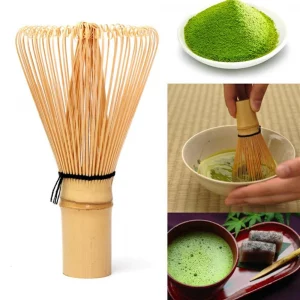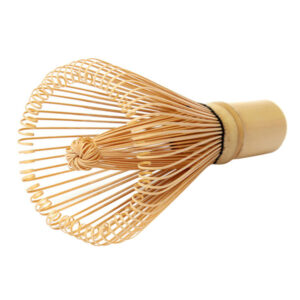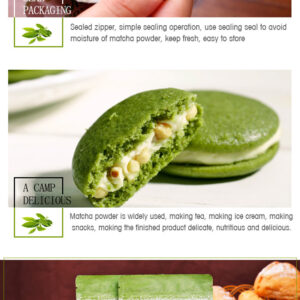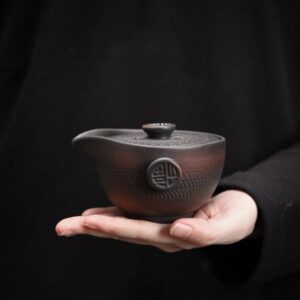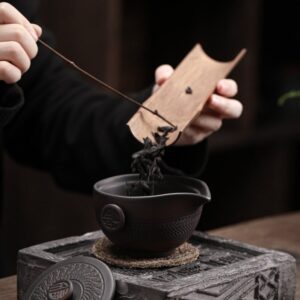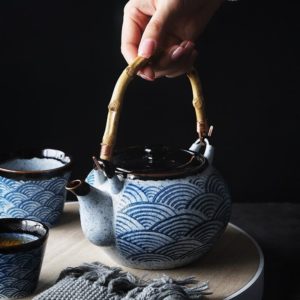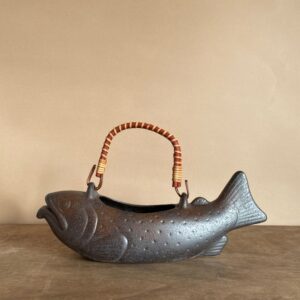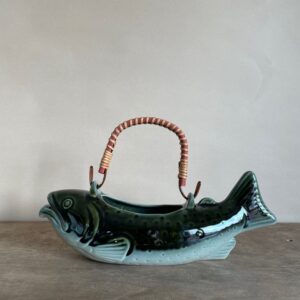Premium Matcha Importer Erin Lindwall is an Australian who, like me, has a deep affinity with Japan. She is also a self-confessed Matcha addict. Matcha is finely ground green tea, grown in the shade which makes it vibrant green in colour. It was historically served in the Japanese Tea Ceremony (Cha No Yu in Japanese) by whisking with water, or more recently added to milk to create a Matcha latte. However, in Modern Japan, Matcha has permeated every possible type of food and drink you can imagine. It is very popular in soft-serve ice cream, cake, parfait, Kit-Kat, and so many other delicious iterations.

Erin Lindwall: Premium Matcha Importer

After many visits to Japan, and then a six-month experience living in Kyoto, Erin came home to Australia to find the Matcha available here at the time disappointing. Deciding to draw on her connections and experience, Erin began importing Matcha, Matcha shakers (to make it easily), and now Chawan (tea bowls) and Matcha Yu Tea was born.
Matcha Yu Tea’s Premium Tasting Matcha is an authentic high-grade Japanese quality, with the additional advantage of providing exceptional health benefits. Erin had come to enjoy these benefits while living in Japan. Matcha boosts energy, is calming and excellent for the immune system and is also beneficial for the skin.

Matcha Yu Tea Company

Matcha Yu Tea is an eco-conscious and environmentally motivated business, offering organic green tea & Matcha, delivered in home compostable packaging. Her company ethos is borne from a deep respect and appreciation of the tradition surrounding tea in Japan.
I started by asking Erin how she had become obsessed with Japan and what led to her living there for 6 months in 2010.
Erin: “Well it all started in my first year of high school, year seven. I took Japanese. Actually, it wasn’t an elective at that point, it was compulsory to do a semester in the Japanese language.
Usually, when you start to learn a language, you learn about the culture. It comes hand in hand and it was just fascinating for me. I was only 13, so I was pretty young and impressionable. I hadn’t done a lot of global travel; I had only been to New Zealand so far.
So, it was this fascinating place over the other side of the world, where everything was so different to what I knew here. I kept studying Japanese and then I took it as an elective through years 9 and 10.
I did a pretty deep dive into the culture. I didn’t take it in Year 11 and 12 because I was a bit worried about actually having to do it in an exam situation, the verbal aspect. I was thinking, oh gosh, I’m not ready for that. But I wish I had continued”.
Fuji Rock Festival

Erin resumed her Japanese studies at night school in Sydney. Her first journey took place in 2002. In an internet music chatroom, she contacted a Japanese girl who told her about the Fuji Rock Festival and said she was going the following year. Erin worked in music and believed this was a fantastic opportunity. Her new online friend agreed to purchase a ticket for her.
Erin had a European trip planned with a friend in 2002, and so she changed her ticket to come home via Japan. She flew to Japan by herself and arrived in Tokyo.
Erin: “After a long-haul flight from Germany, I was blown away. I caught the train to Shibuya and did the crossing. It thought…what is this place? I was pretty tired and I had to find my accommodation. So, I got there and got all settled.
I remember getting into my room and my mum had written me a letter to arrive when I got there…I opened it and read it while I was in the hostel and I just cried because I was so overwhelmed and tired. I was on my own and I just felt so alone.
I’m in this crazy foreign place. I don’t know a lot of Japanese, and then I kinda got over myself and I’m like…Erin, you’re in this amazing place. This is great. Have a rest and then go out there.”
Travelling Around Japan

“So, I walked the streets of Tokyo for about three days. I spent lots of time in Harajuku. Then my friend Shiho met me and we took the train together to Fuji Rock Festival…it was the best festival, world-class.
I loved the festival so much, I decided I’m coming again next year. As soon as I got home, I started planning the next trip and I went again. I did three weeks then so I could see a few other places.
I visited my friend in Kobe, went to Kyoto for the first time, and went to Osaka and Tokyo. Then, as you know, the obsession continues and you just keep planning the next trip and the next trip. I have now done about eight trips”.
Erin was trying to work out how to work and live in Japan when she met her husband, Mick. As she edged closer to 30, she knew she was soon going to be ineligible for a working holiday visa.
Erin: “Yeah, it was only two years we were married. But we were so secure in our relationship and I think he knew I had had to get it out of my system. I would probably still be there for it if I wasn’t married, you know, like six months was great, but it was just scratching the surface.

I was teaching English at a conversational language school called Gaba. I was a bit limited because a lot of the schools need a university degree and I didn’t have that. I had an advanced diploma in marketing, but that doesn’t really cut it. So, I did a crash course in TESL, teaching English (as a second language). And that was enough for Gaba to accept me. They had learning studios in Tokyo and a few in Osaka.
They only have one in Kobe and one in Kyoto. I specifically asked for the Kansai area. I said Kyoto would be amazing because I have a couple of friends there. They got me in there. So that was incredible.
It did feel magical living there for that period. Teaching was a bit…” I’ve never done this before”…but you just adapt and it was a means to be there and support myself. So, it was enjoyable”.

Erin’s Love of Matcha

I then asked Erin how her love of Matcha evolved into an importing business. Was it something in which she had had prior experience?
Erin: “No. Would you believe I wasn’t actually so much into drinking Matcha back when I lived there? I loved Matcha flavoured products. Loved all the desserts and parfaits. My flatmate at the time called me a Matcha addict. But the whole drinking of it was still a bit new to me”.
During Erin’s time teaching, a woman came in wanting to learn English in order to expand her family business. She was interested in the export market. Her father was running an award-winning tea farm. He was a seventh-generation tea farmer in Uji.
Erin: “I hadn’t been to Uji and it was amazing.
This Matcha tea farm had been awarded an Emperor Award over 20 times. The father met the Emperor, and, at that time, it was the only tea farm to receive an Emperor award for the Tencha. The leaves before it becomes Matcha. It really stuck with me.
I remember walking out that day after teaching thinking “I’ve got to do something with this”. It’s such an interesting story. The plan was when I got back to Australia…to open a Japanese dessert cafe.
That was the original idea. I was going to bring in her tea, to sell at the cafe. I did initial research. This was back in 2011, and I just felt the market was too new. It wasn’t ready for that. You could get Matcha in Asian supermarkets, but the whole boom hadn’t happened with Matcha here.
So, I got a bit gun shy…and I’d never worked in hospitality. I thought, “I don’t think it’s the right decision right now, too risky”…Anyway, I went back to work at Sony Music and got back into life”.
Sometime down the track while on maternity leave, Erin revisited the idea of importing Matcha. Matcha was gaining popularity; she was still in contact with the award-winning tea family in Japan and she felt the quality of Matcha in Australia was underwhelming. She decided to “give it a go and see”.
That is how my journey as a Premium Matcha Importer for Matcha Yu Tea started.

Keeping that Connection with Japan with Matcha
Erin: “It was a way of being able to keep that connection with Japan alive on a daily basis. Because I knew it wasn’t practical for us to live there, it’s a way of keeping that joy and excitement and bringing Japanese culture to people here”.
One of the points of difference with Matcha Yu Tea is the compostable packaging, an important sustainable feature that all Premium Matcha Importers should adhere to. Erin and Mick are very focused on saving the planet. Erin couldn’t source anything suitable in Australia but found a product she was very happy with in New Zealand.
The company has a great ethos. They are pioneers in the field and have been making compostable bags for 25 years. They are more expensive but fit with Erin’s principles. Erin believes sustainable packaging also fits her customers’ eco-consciousness.
Erin: “It’s a good point of difference and it lets me sleep at night. I’m not just pushing plastic and going against my own values. So, it is very important. It would have been a deal breaker if I could not put it in that kind of packaging”.
The things Erin misses most about Kyoto and Japan are her Mama Chari bicycle, her local supermarket-Matsumoto, the Hankyu train line carriages, the Konbini, snow, the Sento (bathhouse), the politeness and quietness of the people (especially on trains), and Matcha parfait.

“Visit a teahouse, visit a bathhouse, experience an overnight temple stay, walk the Kamo River in Kyoto and travel to Japan at least once during cherry blossom season. The foods she suggests trying are zaru soba, cold soba noodles with a delicious dipping sauce, onigiri, Taiyaki (fish-shaped sweet pastry with matcha, chocolate, adzuki bean or custard filling) and shojin ryori, vegetarian temple food.”
Quick Questions:
- Favourite food: Matcha parfait and Japanese breakfast
- Favourite Sake: Kaze no Mori
- Favourite Kombini: 7-Eleven and then Lawson
- Favourite anime/author/movie: Miyazaki movies, Murakami books, Departures (a Japanese film about a funeral director) and Lost in Translation (because it captures the sense of overwhelm of being in Tokyo).



































